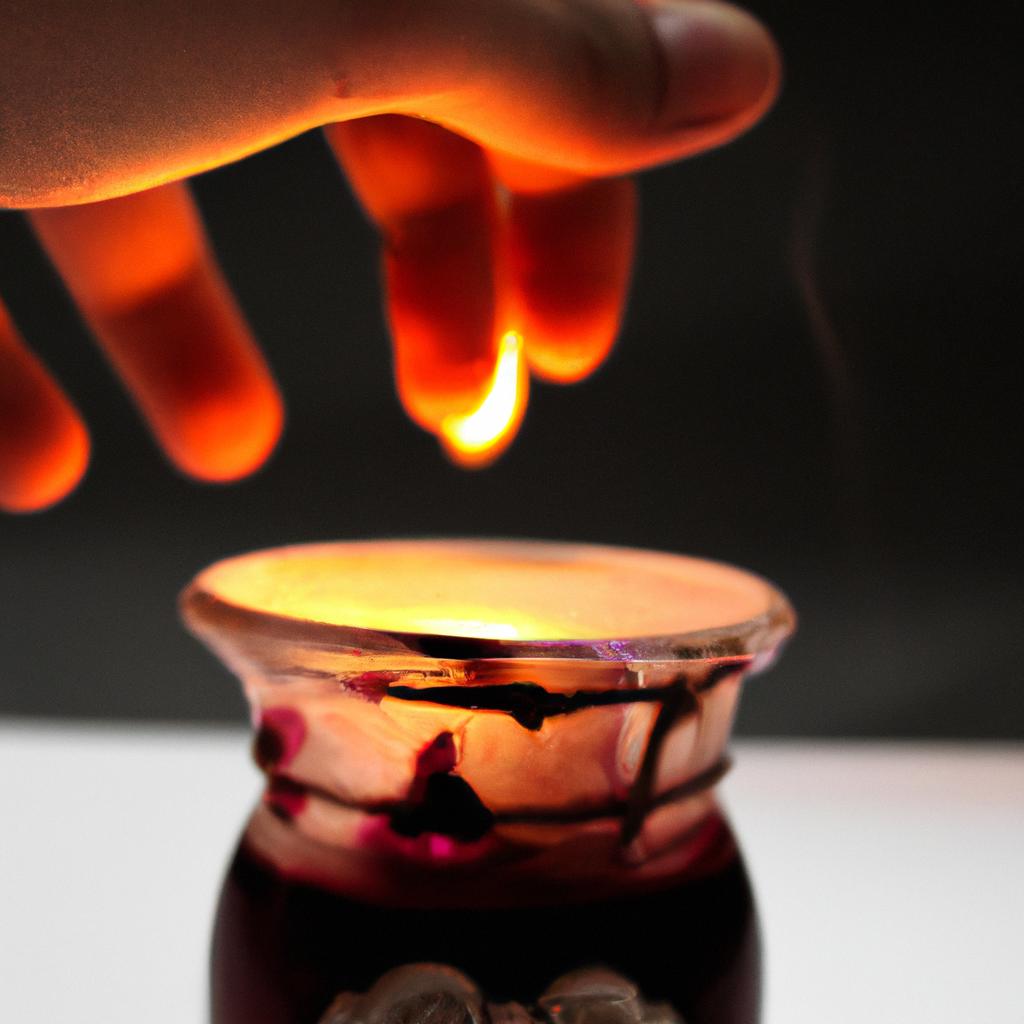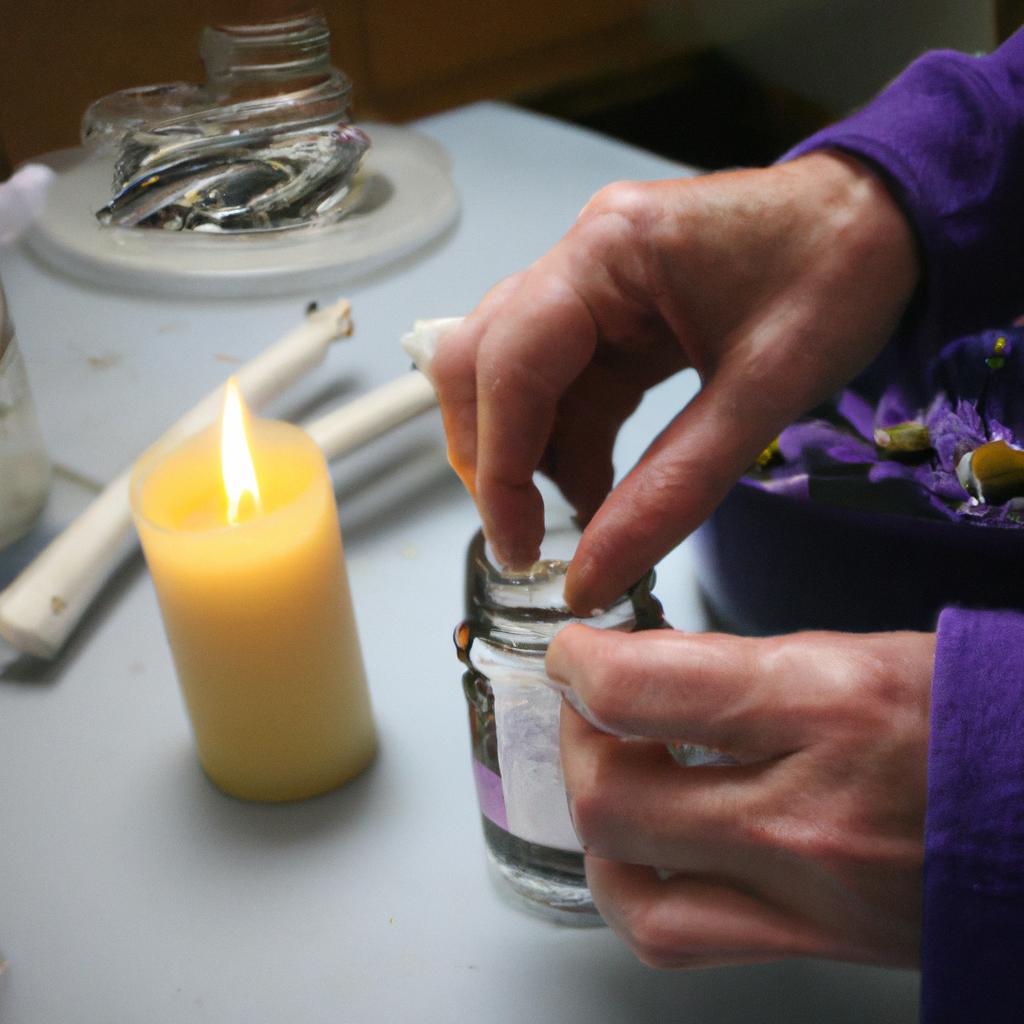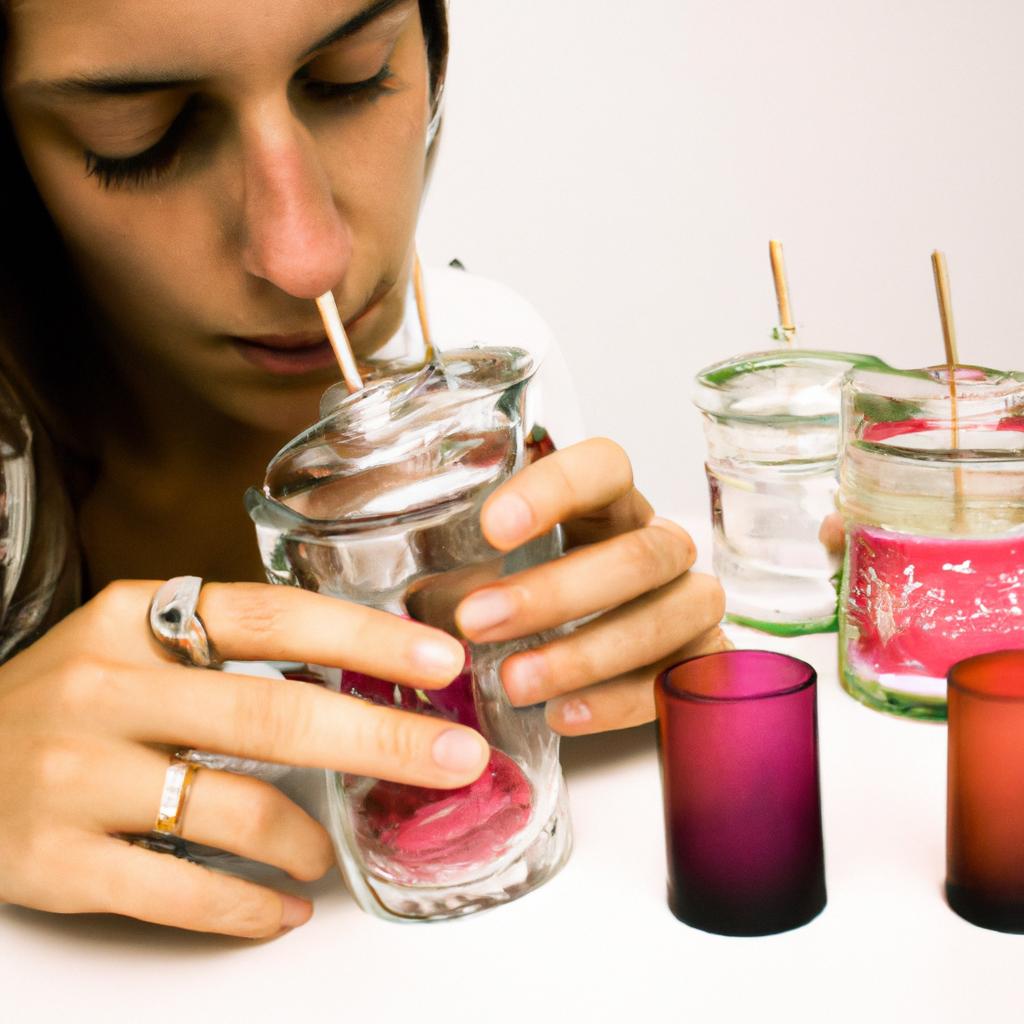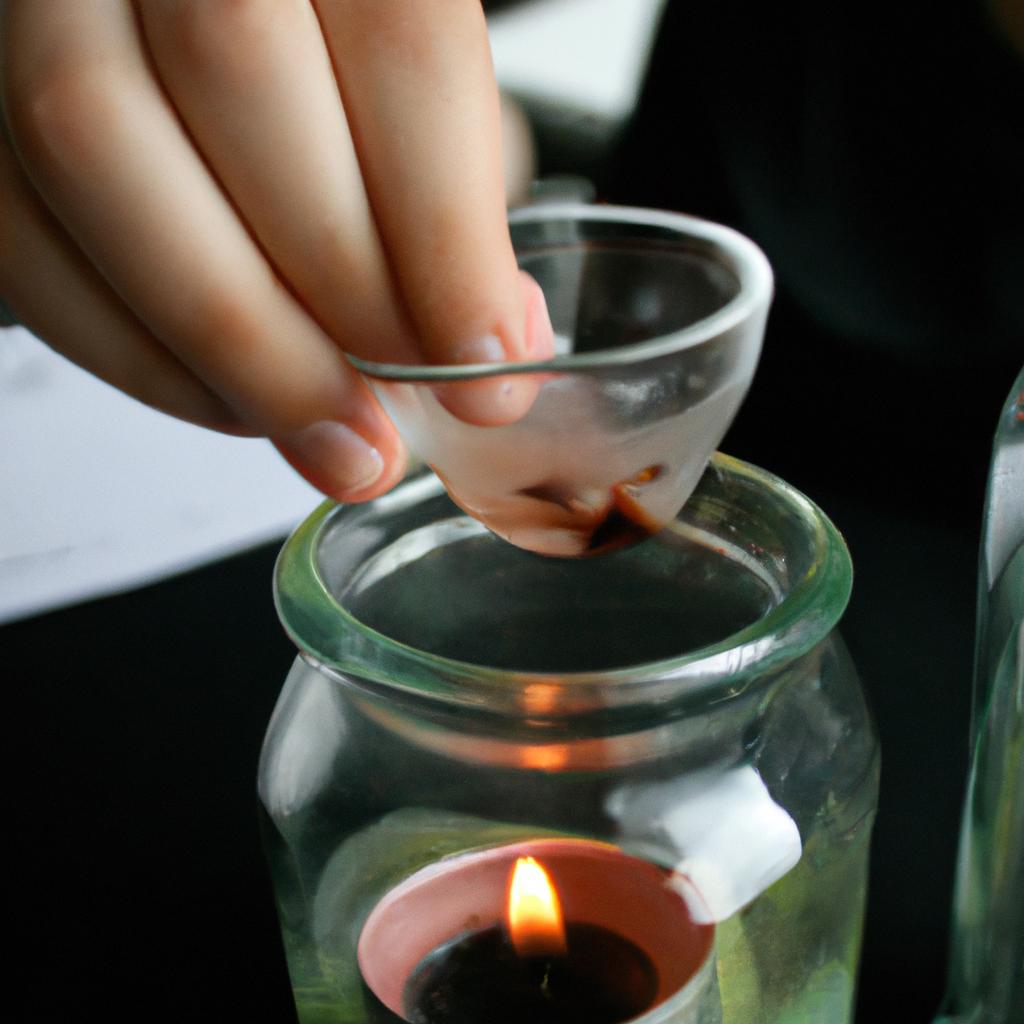Synthetic Candle Fragrances: Fragrance Options for Candle Making

The use of synthetic candle fragrances in the art of candle making has gained significant popularity over the years. With an array of fragrance options available, candle makers now have the opportunity to enhance their creations and create unique olfactory experiences for consumers. For instance, imagine a scenario where a candle maker wants to create a cozy and warm atmosphere with their candles. By utilizing synthetic fragrances such as vanilla or cinnamon, they can effectively evoke feelings of comfort and nostalgia within the consumer.
This article aims to explore the various fragrance options that are readily accessible for candle makers who opt for synthetic scents. Synthetic candle fragrances offer numerous advantages, including consistency in scent quality, cost-effectiveness, and availability throughout the year when compared to natural alternatives. In recent years, there has been substantial growth in the development and refinement of these synthetic aromas, leading to an extensive range of choices for crafters. This article will delve into some popular synthetic fragrance options commonly used in candle making, highlighting their characteristics and potential effects on mood and ambiance.
Understanding Synthetic Fragrances
Imagine walking into a candle shop and being instantly enveloped in the captivating scents of lavender, vanilla, or fresh linen. These delightful fragrances have the power to transport us to different places and evoke various emotions. However, what many people may not realize is that not all candle fragrances are derived from natural sources like essential oils. In fact, synthetic fragrances play a significant role in creating these enticing aromas. This section aims to provide an understanding of synthetic fragrances, their benefits, and how they contribute to the art of candle making.
Benefits of Synthetic Fragrances:
Synthetic fragrances offer several advantages for both candle makers and consumers alike. Firstly, they allow for greater consistency in scent profiles compared to natural fragrances which can vary due to factors such as weather conditions or crop variations. This reliability ensures that candles will emit consistent and long-lasting aromas throughout their burn time.
Secondly, synthetic fragrances offer an extensive range of options that cannot be replicated with solely natural ingredients. Manufacturers can create unique fragrance combinations by blending multiple synthetic components together, resulting in novel scents that cater to diverse consumer preferences.
Thirdly, using synthetic fragrances allows for cost-effective production without compromising on quality. Natural fragrance materials tend to be more expensive due to limited availability or labor-intensive extraction processes. By utilizing synthetics, candle makers can produce high-quality products at affordable prices while still offering a wide array of appealing scents.
Lastly, synthetic fragrances often undergo rigorous safety testing procedures before being used in candles. This ensures compliance with regulatory standards regarding allergenicity and toxicity levels, providing peace of mind for both manufacturers and customers.
Emotional Response (Bullet Point List):
- Discovering new aromatic experiences
- Creating ambiance and relaxation through curated scents
- Nostalgia evoked by familiar smells
- Personal expression through individual fragrance choices
Table: Comparing Synthetic vs Natural Fragrances
| Synthetic Fragrances | Natural Fragrances |
|---|---|
| Consistent scent profiles | Variability in scent |
| Wide range of options | Limited selection |
| Cost-effective production | Higher cost due to limited resources |
| Rigorously tested for safety | Potential allergenicity or toxicity |
Understanding synthetic fragrances is essential in appreciating the artistry behind candle making. The benefits they offer, such as consistency, versatility, affordability, and safety, make them a valuable tool for creating captivating scents. Now that we have explored the world of synthetic fragrances, let’s delve into popular fragrance options commonly used in candles.
Popular Fragrance Options for Candles
Understanding Synthetic Fragrances: Exploring the Possibilities
Imagine a scenario where you walk into a candle store and are immediately captivated by the enchanting scents that fill the air. Have you ever wondered what makes those scents so alluring? In this section, we will delve deeper into understanding synthetic fragrances and how they can be used to create unique and captivating candles.
To illustrate the potential of synthetic fragrances in candle making, let’s consider an example of a small home-based candle business. Sarah, an aspiring entrepreneur, has recently started her own line of handmade soy wax candles. She wants to offer her customers a wide range of fragrance options that go beyond traditional essential oils. This is where synthetic fragrances come into play, offering endless possibilities for creating distinctive scent combinations.
When it comes to synthetic fragrances for candle making, there are several factors to consider. Here are some key points to keep in mind:
- Variety: Synthetic fragrances provide an extensive selection of scents that may not be readily available through natural sources alone. This opens up a world of opportunities for candle makers to experiment with unique combinations and cater to diverse customer preferences.
- Consistency: Unlike natural ingredients which can vary from batch to batch, synthetic fragrances offer consistent results in terms of scent strength and longevity. This reliability ensures that each candle produced maintains its intended aroma throughout its lifespan.
- Complexity: Synthetic fragrances often feature intricate blends of multiple scent notes, allowing for complex fragrance profiles that can evoke specific moods or emotions when lit. From fresh and invigorating citrus blends to warm and comforting vanilla undertones, these multi-dimensional fragrances add depth and character to candles.
- Affordability: Compared to certain rare or exotic essential oils, synthetic fragrance oils tend to be more cost-effective while still delivering high-quality aromas. This affordability enables candle makers like Sarah to broaden their product offerings without compromising on quality.
In summary, synthetic fragrances offer candle makers a vast array of options to create candles that captivate the senses. Their versatility, consistency, complexity, and affordability make them an attractive choice in the world of candle making.
Exploring Floral Scents for Candle Making
Imagine walking into a room filled with the delightful aroma of fresh flowers. The enchanting and captivating scents of floral fragrances have long been popular in candle making, creating an atmosphere that is both calming and invigorating. Whether you want to fill your home with the scent of blooming roses or the soothing fragrance of lavender, there are various options available for incorporating floral notes into your candles.
One example of a widely loved floral fragrance in candle making is jasmine. Known for its intoxicatingly sweet and exotic scent, jasmine adds a touch of elegance to any space. Its delicate yet powerful aroma can evoke feelings of relaxation and serenity. By infusing your candles with the essence of jasmine, you can create an ambiance reminiscent of a tranquil garden oasis.
To help you explore different floral scents for your candle making endeavors, here are some noteworthy options:
- Rose: Symbolizing love and romance, rose-scented candles offer a classic and timeless appeal.
- Lavender: With its calming properties, lavender fragrances promote relaxation and aid in stress relief.
- Peony: Known for its lush petals and soft fragrance, peony scented candles add a touch of femininity to any setting.
- Lily of the Valley: These delicate white flowers produce a subtle yet invigorating scent that rejuvenates the senses.
In addition to these enticing options, consider utilizing the following table as inspiration when selecting floral scents for your candle making projects:
| Fragrance | Description | Emotional Response |
|---|---|---|
| Jasmine | Exotic | Elegance |
| Gardenia | Intense | Opulence |
| Magnolia | Sweet | Serenity |
| Lilac | Fresh | Nostalgia |
By carefully choosing from this selection of delightful floral fragrances, you can craft candles that not only fill your space with captivating scents but also evoke a range of emotions in those who experience them.
Transitioning into the next section about “The Allure of Citrus Fragrances in Candles,” we delve into another category of fragrances that has its own unique charm.
The Allure of Citrus Fragrances in Candles
As we delve into the world of fragrance options for candle making, let us now turn our attention to floral scents. Imagine a bouquet of fresh flowers filling your space with their delicate and alluring aromas. Floral fragrances have long been popular in candles, evoking feelings of serenity and tranquility. One such example is the enchanting scent of lavender, known for its calming properties.
To further understand the appeal of floral scents in candles, consider these factors:
- Variety: The availability of various floral notes allows for endless possibilities in creating unique fragrances. From rose and jasmine to lily of the valley and peony, each flower brings its own distinct aroma to the blend.
- Mood Enhancement: Floral scents are often associated with positive emotions and can uplift one’s mood. They create an inviting atmosphere that promotes relaxation and rejuvenation.
- Aromatherapy Benefits: Many floral scents possess therapeutic qualities that promote well-being. For instance, chamomile has soothing properties that aid in stress reduction, while ylang-ylang is believed to enhance sensuality.
- Personal Preferences: Individuals are drawn to specific floral scents based on personal experiences or cultural backgrounds. Some may prefer the softness of lilac, while others may be captivated by the invigorating essence of magnolia.
Let us now examine a table showcasing popular floral fragrances commonly used in candle making:
| Fragrance | Description | Emotional Response |
|---|---|---|
| Rose | Romantic and elegant | Sensual |
| Jasmine | Exotic and intoxicating | Calming |
| Lily of the Valley | Delicate and fresh | Innocent |
| Peony | Lush and feminine | Luxurious |
Incorporating these captivating floral scents into your candle creations can truly elevate the ambiance of any space. By carefully selecting and blending floral fragrances, you can evoke a wide range of emotions and create a sensory experience that captivates your audience.
Transitioning seamlessly into our next section, let us now explore the allure of citrus fragrances in candles. The refreshing and invigorating nature of these scents adds a vibrant touch to any environment, making them an enticing choice for candle enthusiasts seeking a zesty olfactory experience.
Choosing Woody and Earthy Scents for Candles
Transitioning smoothly from the allure of citrus fragrances, candle makers also have the option to explore woody and earthy scents. These fragrance options can add a sense of warmth and grounding to candles, creating an inviting ambiance in any space. Let’s delve into the world of choosing woody and earthy scents for candle making.
Imagine walking through a serene forest, surrounded by towering trees and crisp autumn leaves. This experience can be captured in a candle with the use of woodsy fragrance notes such as cedarwood, sandalwood, or patchouli. For instance, consider a case study where a candle maker blends these three scents together to create a unique olfactory experience reminiscent of wandering through nature’s embrace.
When selecting woody and earthy fragrances for candles, it is essential to understand their characteristics and how they harmonize with other scent profiles. Here are some key considerations:
- Scent Intensity: Woody and earthy fragrances tend to have medium to strong intensities that can easily fill a room.
- Complementary Scents: Consider pairing these scents with warmer accents like vanilla or spices for added depth.
- Seasonal Appeal: Certain woodsy fragrances may evoke specific seasons or moods; choose accordingly based on your desired atmosphere.
- Target Audience: The preferences of your target audience should guide your selection process – do they prefer more masculine or feminine scents?
To further illustrate this point, let us present a table showcasing different combinations of popular woody and earthy fragrance oils:
| Fragrance Combination | Description |
|---|---|
| Cedarwood + Vanilla | A comforting blend perfect for cozy winter evenings |
| Sandalwood + Rose | An elegant combination that adds sophistication to any setting |
| Patchouli + Bergamot | A bohemian mix that brings about feelings of relaxation |
| Vetiver + Lavender | A calming duo that promotes tranquility and stress relief |
As we explore the world of woody and earthy fragrances for candles, it becomes apparent that these scents have a unique ability to transport us to serene natural environments. In our next section, we will delve into the exciting realm of combining different fragrance profiles to create truly distinctive candle scents – an art form that allows candle makers to craft their own olfactory masterpieces.
Unique Fragrance Combinations for Candle Making
Transition from previous section:
Building on the exploration of woody and earthy scents for candle making, we now delve into the realm of unique fragrance combinations. By blending different aromas together, candle makers can create captivating scents that capture the imagination and enhance various settings. This section explores some intriguing combinations that push the boundaries of traditional fragrances.
Unique Fragrance Combinations for Candle Making
To illustrate the power of unique fragrance combinations, let’s consider an example where a skilled candle maker sought to evoke memories of a serene summer evening in their creation. By combining notes of fresh lavender, zesty lemon verbena, and warm vanilla, they created a scent reminiscent of strolling through blooming fields as the sun sets. This careful blend captures both tranquility and vibrancy, transporting individuals to idyllic moments with just one whiff.
When it comes to crafting memorable candles with unique fragrance combinations, several factors should be considered:
- Balance: Striking a harmonious balance between different scents is crucial to creating an appealing aroma. Each component should complement others without overpowering or conflicting.
- Contrast: Incorporating contrasting elements can add depth and complexity to your candles’ fragrances. Pairing sweet floral notes with spicy undertones or mixing citrus zestiness with creamy vanilla creates intriguing olfactory experiences.
- Storytelling: Crafting candles goes beyond mere sensory pleasure; it allows creators to tell stories through scents. Combining fragrances thoughtfully can transport users to specific locations or evoke cherished memories.
- Experimentation: Don’t shy away from experimenting with unconventional pairings! Some remarkable fragrance combinations arise from unexpected sources, so don’t hesitate to explore new possibilities.
To further inspire your creativity in designing distinctive candle fragrances, here are some evocative examples:
| Fragrance Combination | Description |
|---|---|
| Spiced Orange | Warm cinnamon and zesty orange create a cozy ambiance. |
| Ocean Breeze | Crisp sea salt and refreshing cucumber evoke the seaside. |
| Enchanted Forest | Earthy patchouli, fresh pine, and hints of moss transport you to an ancient forest. |
| Tropical Paradise | Luscious coconut, juicy pineapple, and tropical flowers conjure images of exotic destinations. |
With these unique fragrance combinations in mind, candle makers can unleash their creativity and infuse captivating scents into their creations.
Incorporating an array of fragrances allows for endless possibilities when it comes to creating candles that capture attention and invoke emotions. By combining different aromas thoughtfully, artisans have the power to craft candles that transport individuals to new realms or bring back cherished memories. So go ahead, experiment with unconventional pairings, strike a balance between contrasting elements, and let your imagination run wild as you embark on this olfactory journey of candle making.






